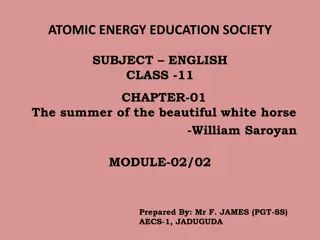Horse Management and Common Terminology Overview
Dr. Ravikant Nirala, Assistant Professor at Bihar Veterinary College, presents comprehensive information on horse management and common terminology associated with equine production. The content covers the position of horses in the animal kingdom, terminology for different horse genders and ages, milk composition, and key terms in equine production. It also discusses breeding seasons, gestation periods, and other essential aspects of horse care and reproduction.
Download Presentation

Please find below an Image/Link to download the presentation.
The content on the website is provided AS IS for your information and personal use only. It may not be sold, licensed, or shared on other websites without obtaining consent from the author.If you encounter any issues during the download, it is possible that the publisher has removed the file from their server.
You are allowed to download the files provided on this website for personal or commercial use, subject to the condition that they are used lawfully. All files are the property of their respective owners.
The content on the website is provided AS IS for your information and personal use only. It may not be sold, licensed, or shared on other websites without obtaining consent from the author.
E N D
Presentation Transcript
General information of Horse and its Management Presented by Dr. Ravikant Nirala Assistant Professor Livestock Production Management Bihar Veterinary College, Patna - 14
Position in Animal kingdom Kingdom: Animalia Phylum: Class: Order: Family: Genus: Species: Chordata Mammalia Perissodactyla Equidae Equus Equus caballus Equus asinus
Common terminology associated with Swine Species: Equus Adult male: Stallion Adult male breeder: Stud Adult female: Mare Young born male/ female : Foal Young male upto 3 yrs: Colt Young female upto 3 yrs: Filly Gestation period: 336 days Age of Maturity: 15-24 months Breeding life 18 years Estrous length: 21 days + 5days Estrous Period: 4 to 6 days Normal temp.: 99.5-101.3 F Male: Female= 1:30-40 RR: 8-16 HR: 32-44 Av. Productive life: 20-25 yrs
Castrated male: Castrated female: Spayed Female with offspring: Suckling Young weaned male/ female : weanling Act of Parturition: foaling Act of mating: Covering Sound: Gelding Meat of Swine: kinophagia Volume of Semen: 75 -150 ml Sperm count: 150 million/CC Best breeding season: Early spring First heat after Partuirition: 4- 14 d Neigh
Milk composition C : 6.1 % P : 2.7 % F : 1.6 % M : 0.51 % Water: 90 %
Terminology in Equine Production Mare: A mature female horse of four years of age and given birth of a foal. Stallion: A mature uncastrated male horse of four years of age. Gelding: A castrated male horse of all ages. Colt: A young uncastrated male horse. Filly: A young female horse under 3-4 years of age. foaling . mare. After
Foal: A young horse of either sex under the age of one year such as Colt foal and Filly foal. Foaling: The act of giving birth by mare. Foal at foot: A suckling foal running with its dam/mare. Covering: Mating in horses. Broodmare: Amare that is used for horse breeding.
Stud: An establishment where pedigreed stallion being kept for breeding. Stud Book: A list of horses of a particular breed whose parents are known. Hand: A measurement of the height of a horse. One hand is equal to 4 inches. The measurement is usually taken from the ground to the withers. Pony: A horse breed that typically measures shorter than 14.2 hands (58 inches, 147 cm). it is used in sport of polo. Horses: Individual animals of breeds that typically measure over 14.2 hands (148 cm, 58.27 in) of height without shoes and over 14.2 h (149 cm, 58.66 in) (just) with shoes. Cut off height: 14 hands
Jack: An uncastrated male donkey or ass. Jennet/Jenny: A female donkey. Jockey: The rider of a horse in horse racing. Mule: Hybrid offspring of a male donkey and a horse mare. Almost always sterile. Mules are noted for their sure- footedness. Hinny: The sterile hybrid offsprings of horse stallion and female donkey. Zebroid: Hybrid offspring of a zebra crossed on another equine.
Neigh: A sound made by a horse. Stable: A building in which horses are kept. Grooming: Cleaning horses for hygienic, practical or esthetic reasons. Doping: Illegal use of medicinesto improve a horse's performance in racing/showing or to harm an animal to perform poorly by an opponent. Farrier: A professional hoof care specialist who does hoof trimming and horse shoeing.
Horses Family: Equidae caballus Scientific name: Equus Odd-toed ungulate mammal. Important role in transportation, agriculture, sports and warfare. Light riding horses: 14.0-16.0 hands weighing 386-540 kg. Ex. Arabians, Morgans, Quarter Horses. Larger riding horses: 15.2-17 hands weighing 540-680 kg. Ex. Thoroughbreds, American Saddlebreds, Warmbloods. Heavy/draft horses: 16.0-18.0 hands weighing 680-900 kg. Ex. Clydesdale, Belgian, Percheron and Shire.
Pony Shorter than 14.2 hands (58 inches, 147 cm). Ponies often exhibit thicker manes, tails and overall coat. Proportionally shorter legs, wider barrels, heavier bone, shorter and thicker necks and short heads with broad foreheads. Calmer temperaments than horses and high level of equine intelligence.
Donkey Donkeys' ears are much longer in proportion to their size. Straighter necks and back due to lack of true wither. Coarse mane and tail. Smaller and rounder hooves with more upright pasterns. Characteristic brassy bray sound. Colors from gray shades of gray-dun to brown, black, light- faced roan. Sizes: 36" and under (Miniature Mediterranean), 36.01-48" (Standard), 48.01" to 56" (Large Standard).
Mule Body of a horse with the extremities of a donkey. Grow taller than both parents due to hybrid vigour. Stronger than horses. Long ears, short thin mane, tail with shorter hairs. Legs like the donkey with small and upright hooves. Stubbornness and bad-tempered but highly intelligent.























